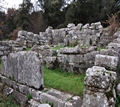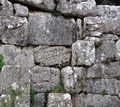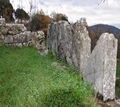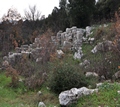
The archaeological site of ancient Lykosoura is located in the southwestern part of Arcadia, on the eastern side of Mount Lykaios, in a lush and idyllic environment. It is 49 km from Tripoli and 12 km from Megalopolis.
The sanctuary of the local deity, who called her Despina, is one of the most important sanctuaries of ancient Arcadia. It flourished until the end of Roman times.
The most important monuments of the Archaeological site are:
1) The Temple of Despina
2) The Megaro (Altar)
3) The Great Stoa and the Altars
4) The Ancient Fountain-Reservoir.
The sanctuary of Despina in Lykosoura was a complex of altars and temples dedicated to various deities. But the temple and the palace of Despina were the best. There, from a very old time, an arcane orgiastic celebration took place, with a representation of the birth of Zeus, where teenagers impersonating the Curites and Koryvantes took part, who danced enthusiastically brandishing weapons and making inarticulate screams.
Despina was one of the primordial chthonic deities, in whose honor there were mysterious cult ceremonies, which, as well as her name, were known only to those initiated into them. "Despina" was not the real name of the goddess but an epithet by which she was referred to. Mysterious and unnamed goddess, the invoked Despina, whom Pausanias identifies with Kori, seems to have indeed been Persephone, daughter of Poseidon and Demeter.
Despina was inextricably linked with the Arcadian cult. He held a special place among the archaic gods and for this reason there was continuity from one era to another. This is evident both in the various finds representing different eras, as well as in the huge complex of Damophon, where his modern art is connected with the Arcadian tradition.
Lykosoura was the holiest and most ancient city of the Arcadia. It was founded by the mythical king Lycaon, son of Pelasgus. According to traditions the city was considered the oldest on the mainland and the islands. The city was visited by Pausanias, and he even wrote in his work Tour of Greece that it is the first city that the sun saw!..
Lykosura, considered "the oldest city in the world", continued to exist when after 360 all the other Arcadian cities united, forming Megalopolis. The sacraments continued to be celebrated, as a 3rd century BC inscription informs us.
The archaeological site includes a temple, enclosure, a large altar on two levels (megaro), where official ceremonies took place, the great stoa, remains of Baths, and the altars of Despina, Demeter and the Great Mother. The surviving ruins are from the 2nd century BC.
In the temple of Despina was found the pedestal of the famous "constituent" of the Messenian sculptor Damophon (complex of the colossal statues of Athena, Demeter, Artemis and the titan Anytos) of the 2nd BC. century, as well as fragments of the statues of the gods. The cult statue depicts Despina enthroned, with the cyst on her knees, while the goddesses Demeter and Artemis stood next to her.
On the veil of the statue of Despina at Lykosoura were depicted all kinds of musicians disguised as animals, with masks in the shape of a stallion as well as creatures with the head of a cow or a pig. At the base of the statue were depicted Kouretes and Koryvantes. Rather it indicates the existence of a cultic troupe of masked men and a mystical society of warriors in the sacrificial circle.
According to Herodotus, predorian mysteries of Demeter were observed in Arcadia.
Despina's palace is a temple-like building with an open-air altar. It was a sacred place where initiation rites and sacramental sacrifices took place. On the great altar, dismemberment sacrifices were made. Above the megaron there was a grove and at the top of the hill a sanctuary of Panos.
Impressive are the votive statuettes of skull-headed people in long robes.
In the SW. of the palace there is a building made of large rectangular stones. There is also a monumental construction of ten rows of pews on the side of the temple, from where the pilgrims watched the events.
Next to the archaeological site, the small one-room Archaeological Museum of Lykosoura has been created, which houses part of the finds from the Sanctuary of Despina in Lykosoura.
The Museum includes the following collections:
Sculptures, inscriptions, marble and clay votives of various types from the Sanctuary of Despina in Lykosoura, Arcadia, as well as various small finds from the area around the Sanctuary.
Editor: Fotini Anastasopoulou









